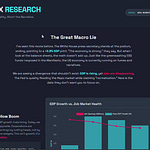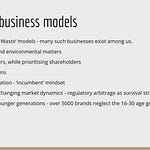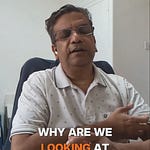In the dynamic world of finance, the headlines often paint a picture of relentless growth and market highs. Yet, for the discerning individual LP and professional investor, a deeper look reveals a more complex reality. We're witnessing a profound disconnect: soaring equity valuations coexist with persistent economic vulnerabilities, escalating geopolitical tensions, and an undeniable acceleration of ecological challenges. The traditional economic models, which have long served as our compass, are increasingly proving inadequate in navigating these turbulent waters.
This is where eco-economics steps in. Not as a niche investment trend, but as a fundamental paradigm shift. It offers a powerful, pragmatic lens through which to analyze risk, identify genuine value, and build truly resilient portfolios for the long haul. As an individual LP or professional investor, understanding this framework is no longer an academic exercise; it's becoming a critical determinant of your long-term financial success and the security of your capital.
The Unseen Foundation: Why Eco-Economics Matters to Your Portfolio
For decades, conventional economics has largely operated under the assumption that the economy is a self-contained system, capable of infinite growth, with environmental impacts treated as mere "externalities." This perspective, however, fundamentally misunderstands our reality.
Eco-economics asserts a simple, yet profound truth: the human economy is a subsystem embedded within, and entirely dependent on, the Earth's finite ecosphere. Think of it this way: your portfolio relies on companies, which rely on economies, which in turn rely on healthy ecosystems. Clean air, fresh water, stable climate, fertile soil, biodiversity – these are not just "environmental issues"; they are the ultimate foundational assets of all wealth. Ignoring their degradation is akin to investing in a company that consistently dismisses its mounting balance sheet liabilities. Eventually, those liabilities come due.
Let's quickly unpack three core eco-economic principles that directly impact your investment decisions:
Sustainable Scale Before Allocation: Traditional finance prioritizes efficient allocation of capital. Eco-economics argues that before we optimize allocation, we must ensure the economy operates within sustainable planetary boundaries (its "scale"). Only then can we consider fair distribution of resources. This reordering helps you identify businesses whose growth models are inherently unsustainable and thus carry significant long-term risk, regardless of their current profitability.
The Entropy Law: A fundamental law of physics, entropy dictates that every economic activity consumes energy and materials, transforming them into irreversible waste and disorder. There is no free lunch, no infinite material growth on a finite planet. Investments in businesses predicated on perpetual material expansion, or those with highly resource-intensive processes, face inherent biophysical limits that traditional financial models rarely incorporate. Understanding entropy allows you to de-risk your portfolio from companies on a collision course with thermodynamic reality.
Valuing Natural Capital: Ecosystems provide trillions of dollars in essential services (e.g., pollination, water purification, climate regulation) that are often unpriced by markets. This creates a massive "valuation gap." Companies that degrade this natural capital are accruing unbooked liabilities, while those actively preserving or enhancing it are building true, long-term resilience and competitive advantage. As regulations evolve and resource scarcity intensifies, these previously "external" costs will increasingly become internalized, impacting profitability.
By adopting this eco-economic lens, you gain a powerful advantage: the ability to see beyond the immediate financial noise and identify where true, long-term, sustainable value is being created – or destroyed.
Q3 2025 Market Pulse: Reading the Signals Through an Eco-Economic Lens
Let's apply this framework to the current market environment, drawing on the most recent macro events, earnings insights, and commodity market trends.
A. Macro-Economic Update: The Shifting Sands
Inflation & Rates: While headline inflation shows signs of moderation, core inflation remains stubbornly sticky. This keeps central banks globally in a cautious stance, reinforcing the "higher for longer" interest rate narrative. For your portfolio, this means continued pressure on borrowing costs for companies and potentially lower valuation multiples for growth-sensitive assets. An eco-economic view understands that persistent inflation can be exacerbated by resource scarcity and climate-related supply shocks, not just monetary policy.
GDP & Employment: Global GDP growth forecasts for late 2025 are being revised downwards, signaling a continued economic slowdown. Employment figures are mixed, with resilience in some sectors like tech, but layoffs in others. This highlights a bifurcated economy, where overall market buoyancy is often driven by a narrow set of performers rather than broad-based health.
Geopolitics: Ongoing tensions in the Middle East continue to create supply chain jitters, impacting energy and trade flows. Simultaneously, escalating trade disputes between major economic blocs are threatening global trade and commodity prices. These geopolitical events are increasingly intertwined with resource access and climate vulnerabilities, adding layers of systemic risk.
B. Earnings Season Insights: The Corporate Mirror
Tech & AI Dominance: Q2 earnings season saw continued outperformance from mega-cap tech and AI-related companies. Their growth narratives remain compelling, but their high valuations demand scrutiny. Are these companies truly creating sustainable value, or are they benefiting from a speculative bubble?
Traditional Sector Softness: Many traditional industrial and consumer discretionary companies reported softer guidance, citing persistent inflation, higher input costs, and cautious consumer spending. This bifurcation underscores the uneven impact of current economic conditions.
Sustainability vs. Tariffs: A Telling Shift: My analysis of Q2 2025 earnings calls revealed a concerning trend: "sustainability" mentions continued their downward trajectory, significantly overshadowed by discussions on "tariffs" and other immediate geopolitical risks. For you, this is a critical signal. While corporations are rightly focused on immediate pressures, those neglecting long-term ecological and societal considerations may be accruing significant future risks – carbon taxes, stricter regulations, supply chain disruptions due to climate impacts, or reputational damage. This creates an information arbitrage opportunity for investors with a long-term, eco-economic view.
C. Commodity Market Events: Resource Realities
Oil Prices: Brent Crude has seen continued volatility, recently trading around $80-$85/bbl, influenced by OPEC+ decisions and geopolitical events. However, for the eco-economic investor, the strategic imperative remains the accelerating global energy transition. The fact that clean energy investment is set to double fossil fuel investment in 2025 is the undeniable long-term trend.
Critical Minerals: Prices for key transition minerals like lithium, copper, and nickel have shown renewed upward pressure. This is driven by increasing demand from the EV and renewable energy sectors, coupled with persistent supply chain bottlenecks and geopolitical competition for resources. This highlights the material intensity of the green transition and the importance of investing in companies with secure, sustainable sourcing strategies.
Agricultural Commodities: Climate-related weather events, such as persistent droughts in key agricultural regions, are impacting crop yields globally. This is leading to price volatility in agricultural commodities and raising concerns about food security, which can translate into broader inflationary pressures and social instability.
The Aspirations Gap: A New Engine of Market Transformation
Beyond the traditional economic indicators, a powerful, often overlooked, force is reshaping markets: the aspirations gap among younger generations – specifically those under 30 (Gen Z and younger millennials). This demographic is not pursuing the same traditional markers of success as previous generations, and this has profound implications for your investment strategy.
Shifting Priorities: Unlike their predecessors, many under-30s are less focused on traditional markers like homeownership, car ownership, or accumulating material possessions. Instead, they prioritize experiences, purpose, flexibility, digital connection, and a deep concern for social and environmental impact. They are digital natives, highly informed, and globally conscious consumers and employees.
Impact on Consumer Behavior: This translates into a significant shift in spending patterns. They actively seek out brands with strong sustainability credentials, transparent supply chains, and authentic purpose. They prefer access over ownership (e.g., subscriptions, sharing economy models) and are driving demand for plant-based foods, sustainable fashion, ethical consumer goods, and digital-first services. Companies failing to adapt their products, services, and values to this demographic risk losing a massive and growing consumer base.
Influence on Labor & Talent: As they enter and advance in the workforce, this generation demands more than just a paycheck. They seek purpose-driven work, flexibility, and employers who demonstrate genuine commitment to ESG principles. This significantly influences talent acquisition, retention, and ultimately, corporate productivity and innovation. Companies with poor sustainability records or misaligned values will struggle to attract and retain the best and brightest.
Impact on Investment Trends: This generation is also increasingly active in investment, and they are driving the demand for impact investing, ESG funds, and direct investments in sustainable startups. They are not just passive beneficiaries; they are active allocators of their own capital, seeking to align their investments with their values. This creates a powerful, long-term tailwind for sustainable finance.
This "aspirations gap" is not a niche trend; it's a demographic tidal wave that will fundamentally reshape consumer markets, labor markets, and capital allocation over the next two decades. For individual investors, understanding this shift is crucial for identifying future-proof companies and avoiding those whose models are becoming obsolete.
Navigating the Headwinds: Risks You Can’t Ignore
The transition to a sustainable economy, amplified by these demographic shifts, is not without friction. As an investor, you must be acutely aware of the significant headwinds that can impact your returns:
Policy Whiplash: The global regulatory landscape is a fragmented mosaic. In the US, potential federal rollbacks of environmental protections clash with aggressive state-level climate action. In the EU, "simplification" efforts could signal shifts in Green Deal ambition. China continues to build its comprehensive green governance. This fragmentation creates immense regulatory uncertainty, increasing compliance costs and planning difficulty. Your investments need to be robust enough to withstand these swings.
Escalating Litigation & Legal Risk: A dynamic legal front is opening. Recent US Supreme Court rulings on environmental impact assessments and challenges to state-level climate regulations could impact the pace of decarbonization. Simultaneously, climate tort cases against fossil fuel companies are advancing in some state courts, while novel applications of antitrust law are now targeting asset managers for alleged collusion to reduce coal output. This is a rapidly evolving legal minefield that can create unexpected liabilities.
Unpriced Biophysical Risk: This is perhaps the most insidious risk. The market, by and large, still does not adequately price in the true cost of resource depletion, biodiversity loss, or climate impacts. Companies operating with high water footprints in drought-prone regions, or those reliant on fragile ecosystems, carry unbooked liabilities that can suddenly materialize as supply chain disruptions, operational shutdowns, or regulatory penalties. Your portfolio needs to actively assess and minimize exposure to these unpriced, yet inevitable, costs.
Actionable Investment Opportunities: Investing in a Regenerative Future
Despite these risks, and indeed, because of these shifts, the eco-economic transition presents the most significant investment opportunity of our generation. By applying an eco-economic lens, investors can identify companies and sectors building true long-term value and resilience.
Natural Capital Stewards: Look for companies that actively protect, restore, and enhance natural capital. This includes businesses in regenerative agriculture, advanced water management solutions, and ecosystem restoration. As accounting for ecosystem services becomes standard, these firms are better positioned for resilience and have fewer unbooked liabilities.
Clean Energy & Electrification Pioneers: The shift away from fossil fuels is unstoppable. Beyond utility-scale solar and wind, consider investments in energy storage (batteries, hydrogen), smart grid infrastructure, electric vehicle charging networks, and companies developing innovative materials for a decarbonized future. The structural demand for these solutions will continue its exponential growth.
Circular Economy & Resource Efficiency Innovators: The entropy law dictates the need for radically more efficient resource use. Invest in companies that embrace circular economy principles: designing products for longevity, repair, and recycling; using recycled content; developing advanced waste-to-value technologies; and creating service models that replace product ownership. These businesses reduce reliance on finite virgin materials and mitigate supply chain risks.
Adaptive & Resilient Infrastructure: Climate change is already here. Investing in infrastructure that is resilient to extreme weather events, enhances water security, and supports sustainable urban development is a necessity. This includes advanced building materials, smart city technologies, and companies providing solutions for climate adaptation and disaster preparedness. These investments build physical and systemic resilience.
Companies Aligned with New Aspirations: Critically, seek out companies that understand and cater to the evolving values of younger generations – those prioritizing purpose, sustainability, and authentic engagement. These are the businesses that will capture future market share, attract top talent, and build enduring brand loyalty.
Conclusion: Your Fiduciary Duty in a New Era
For individual LPs and professional investors, your fiduciary duty extends beyond quarterly returns. It increasingly encompasses the long-term sustainability of the capital you manage. Integrating eco-economic principles into your investment strategy is not just about ethical alignment; it's about shrewd risk management and capitalizing on the most profound economic and demographic transitions in human history.
The current market disconnects, combined with the rising influence of younger generations, create an unprecedented opportunity. While others focus on immediate pressures, you can identify and invest in companies that are quietly building the foundations for a sustainable future – those that truly understand their dependence on natural capital and are aligning their business models with ecological limits and evolving societal values.
By embracing an eco-economic perspective, you are not just investing in individual companies; you are investing in the health and longevity of the broader system that supports all economic activity. This proactive approach will position your portfolio for resilience and superior performance in a world increasingly shaped by environmental and demographic realities. The time to transcend conventional thinking and invest in the regenerative future is now.











